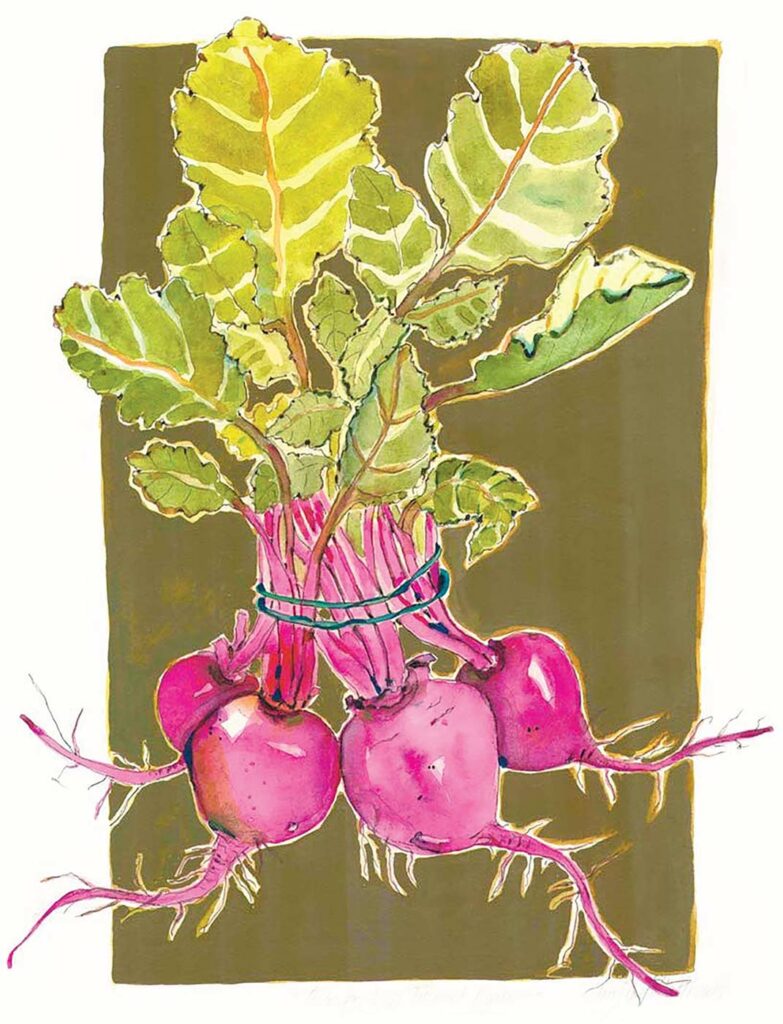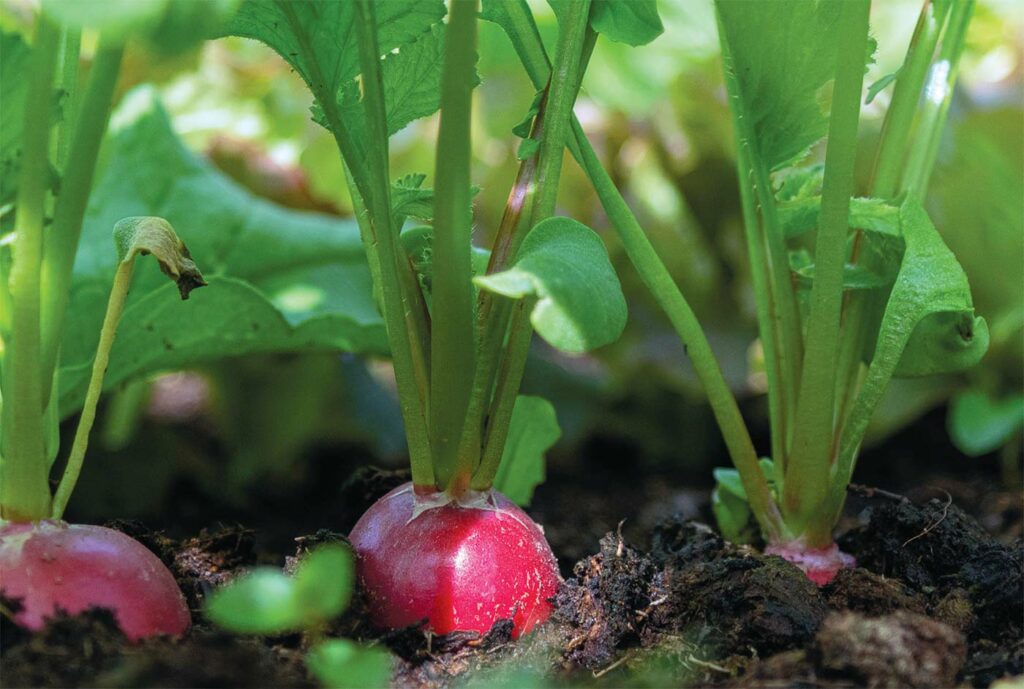
These crunchy, spicy roots are more versatile than you might think
ILLUSTRATION BY CANDY MATTHEWS
I was inspired to write about radishes while on a recent trip to visit my friend Jamie Harson at her diversified 18-acre farm in Duson, Louisiana. Jamie is also owner of a café, Scratch Farm Kitchen, in nearby Lafayette, where she serves delicious, locally sourced food with a Southern twist.
I was thinking about radishes as I devoured Jamie’s Delta Grind Grit Bowl. That day, the rotating dish was loaded with radishes, along with heirloom cherry tomatoes, cabbage and jalapeños. It was topped with egg, a spiced honey and smoked garlic oil drizzle, and a flurry of purple radish microgreens.
Harson clearly has a lot to say about radishes, which she uses in many of her dishes, often in the form of kimchi or pickles. Thus prepared, they provide texture and heat to rich, savory fare like her signature Boudini, a breakfast situation comprised of a housemade biscuit piled with boudin sausage, egg, cheese, chimichurri, mayonnaise and sassafras syrup.
Radishes (Raphanus sativus) are an edible root belonging to the brassica family and thus related to broccoli, Brussels sprouts and cabbage. Like many brassicas, radishes contain a sulfurous compound known to reduce cancer risk as well as other antioxidants; radishes are also a good source of vitamin C. And, like its brassica relatives wasabi and horseradish, radishes get their spicy bite from an organic chemical compound called allyl isothiocyanate, which has shown promise as an anti-inflammatory, antimicrobial and chemopreventive.
GROWING AND STORING
Many farmers on the Central Coast grow radishes in the spring, but they’re suitable for year-round cultivation. Spade & Plow in San Martin grows purple daikon and green luobo radishes; the latter is a zestysweet lime-green variety with a white tip. Live Earth Farm, Blue Heron Farms and Happy Boy Farms grow other varieties including Easter egg radishes—a pretty, rotund type notable for its various pastel colors, and cherry belle, the prototypical crimson radish.
As a farmer, radishes are one of my favorite things to grow because they germinate quickly and are fast and easy to cultivate, with most varieties maturing in just 30 days. Varieties like round black Spanish and watermelon radishes can take up to 60 days to reach full size and are generally used for cooking or pickling, due to their firm texture.
Radishes should be planted in well-tilled soil mixed with compost, and sowed about one inch apart for smaller varieties and up to six inches apart for larger types like daikon. Planting them closer together means you’ll need to thin them to make space for them to grow, but you can then eat the smaller roots while waiting for the others to reach maturity. You can tell the size of a radish by looking at the shoulders of the root (the portion below the stem).
Radishes come in an array of colors, shapes and sizes, with varying degrees of heat. I love the varieties found in the Baker Creek Heirloom Seed Co. catalog, which provides information on their history. Baker also offers red rat’s tail radishes cultivated for their seed pods, which are nutritious and taste like piquant green beans.
I particularly enjoy growing French breakfast radishes. A mild, elongated, rosy variety with an ivory tip, they’re a good starter variety if you’re timid with heat. In France, these crisp little roots are popularly consumed slathered with unsweetened butter, dipped in sea salt and eaten out of hand, or thinly sliced and layered atop butter on a sliced baguette.
To store radishes, wash them to remove any soil and separate the greens from the roots. Add the roots to a small bowl of water and place in the refrigerator; they’ll last up to a week if you change the water every other day.

As a farmer, radishes are one of my favorite things to grow because they germinate quickly and are fast and easy to cultivate, with most varieties maturing in just 30 days.
For the greens, shake the excess water from the stalks, blot with a dishtowel and store in a bag in the produce drawer of your refrigerator. Radish greens are delicate and should be eaten within a few days; they’re wonderful in pesto, wilted and folded into scrambled eggs or a stir fry, or used in place of cabbage for making sauerkraut.
FRESH AND COOKED
Radishes are surprisingly versatile in the kitchen, but note that served whole, they can be too pungent or even bitter, depending upon the variety and growing conditions or season. They can be sliced, grated, mandolined or chopped, and I suggest leaving a quarter inch of stem on radishes being used for crudité. Raw roots are at their best served with a rich, creamy foil like spinach or onion dip, to counter their assertive, peppery flavor.
Alternatively, you can grate fresh radish into a sour cream-based dip flavored simply with chopped herbs like chervil, Italian parsley or mint, minced shallots, a bit of lemon juice, and some kosher salt. Chilled, halved radishes are lovely dolloped with a chive or scallion compound butter.
To best enjoy eating raw radishes, be sure to slice as thinly as possible. Big chunks of raw radish are too pungent. This goes for more than radishes, especially in a salad. A really good salad has a little bite of each component in the forkful.
I grow purple daikon radishes because I enjoy their gorgeous magenta color, mild flavor and light, refreshing texture. They work well when shredded into little bird nests and served underneath fatty cuts of fish like salmon belly or braised pork belly.
To cook radishes, try tossing them in olive oil, salt and pepper and sautéing or roasting until lightly caramelized, or braising them in herbinfused stock or butter. Because of their high water content, I recommend rough chopping smaller radishes or julienning larger varieties for use in stir-fries.
Raw, roasted or fried radish seeds are all tasty and add a satisfying pop to salads and rice and grain dishes.
Illustrator and watercolorist Candy Matthews is a contributor to Edible Shasta-Butte. Reach her at beeznjim@yahoo.com.

Radish Kimchi
Harson says the key to this pungent pickle is vegetarian fish sauce made from pineapple or shiitake mushrooms. It adds a subtly sweet, umami characteristic.
About the author
Jamie Collins is the owner of Serendipity Farms and has been growing organic row crops at the mouth of Carmel Valley since 2001. She distributes her produce through a CSA, u-picks and farmers’ markets.
- Jamie Collinshttps://www.ediblemontereybay.com/author/jcollins/
- Jamie Collinshttps://www.ediblemontereybay.com/author/jcollins/
- Jamie Collinshttps://www.ediblemontereybay.com/author/jcollins/
- Jamie Collinshttps://www.ediblemontereybay.com/author/jcollins/



